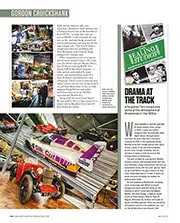

Historic scene with Gordon Cruickshank
A day at the museum A new National Motor Museum exhibition celebrates motor sport in all its guises Stirling Moss seems to get everywhere – and I say that envying…
Some say it’s the most beautiful Ferrari ever, perhaps the most beautiful car of all time. That is a widely held if ultimately subjective claim made for the 275 GTB. A more tangible claim is that it was the first ‘modern’ car to roll out of the Maranello factory. It was Ferrari’s first proper production car with full independent suspension, a transaxle and, in its final incarnation, twin-cam cylinder heads.
Beauty and modernity combined to make the 275 GTB cool and, eventually, an icon of the 1960s. Sophia Loren had one, as did Peter Sellers, Roman Polanski, Catherine Deneuve and Miles Davis. Steve McQueen is reckoned to have had three in his time!
Pininfarina designed the bodywork of the new front-engined two-seater grand tourer, introduced in 1964 to replace the 250 GT SWB Berlinetta. Charged with translating his beautiful lines into metalwork was coachbuilder, Carrozzeria Scaglietti.
But it is what lies underneath that long-nosed coupé shape that gives the 275 GTB such an important place in Ferrari’s history. The car leaned heavily on the competition pedigree of the Scuderia’s early-1960s Le Mans 24 Hours winners. That explains the independent rear suspension and the gearbox at the back of a car that factory sportscar driver Mike Parkes helped develop.
The engine was the tried and tested V12 designed by Gioacchino Colombo, but now enlarged to 3.3 litres. That meant a 275cc capacity for each of the 12 cylinders and explains the type number. GTB, of course, means Gran Turismo Berlinetta.
A power output of 280bhp was quoted for this two-cam engine in the standard three-carburettor configuration. Customers could specify another three Weber carbs with the promise of extra horsepower.
“Beauty and modernity combined to make the 275 GTB an icon of the 1960s”
Ferrari, as ever, had an eye on racing when it developed the 275 GTB. It wasn’t conceived to triumph overall at Le Mans and in international sports car racing, rather to win the GT class. It did just that at its first attempt on the French enduro in 1965 when one of a short run of what was known as Competizione Speciales entered by Ecurie Francorchamps came third overall driven by Willy Mairesse and Jean ‘Beurlys’ Blaton.
The 275 evolved over time, and its racing exploits had a lot to do with that. The nose was lengthened by nearly four inches at the end of 1965 in the name of improved aerodynamics. That change was a lead-in to the introduction the following year of the four-cam engine with an extra camshaft on each bank of cylinders — though still with only two valves in each — and dry-sump lubrication, as well as the six-carb set-up as standard. The 275 GTB/4, with its distinctive bonnet bulge, was born with 296bhp as standard.
The ultimate racing 275 was the GTB/C, 11 of which were built in early 1966 in the factory between production of the two-cam ceasing and the four-cam starting. Every panel was different in the name of weight saving, which shed 150kg from the car.
There was one more 275 GTB derivation commissioned by Ferrari’s North American importer, Luigi Chinetti. The GTB/4 NART Spider paid homage to his North American Racing Team that had claimed Le Mans victory in ’65 with a 250LM driven by Jochen Rindt and Masten Gregory.
Production ceased in 1966 with just over 800 built – not counting the 200 275 GTS roadsters. The final tallies were 456 two-cam cars, 350 four-cams and 10 NART Spiders. It was a milestone car, with more GTBs built than any other Ferrari up to that point.
FERRARI 275 GTB
• Price new £5699
• Price now £1.5-£2.5 million
• Engine 3.3-litre, 24-valve V12
• Power 280bhp
• 0-60mph 6.6sec l Top speed 160mph
• Rivals Aston Martin DB5, Maserati Sebring, Lamborghini 350 GT
• Verdict Stunning classic that helped cement the Ferrari legend
When history and provenance win overall
Housing one of the great Ferrari V12s, the 275 GTB has gone up and down in the market lately. Its eligibility for events is off the charts, from racing to concours, so the 275 GTB has a ticket to some of the most exclusive events.
Reading auction results it’s clear that who’s owned, driven and restored these 275 GTBs is what demands the top money, as well as if it’s got three or six carbs, a Long or Short Nose and if it’s made from alloy or steel. Built from 1964-66 there’s still choice, with the non-matching, older restorations needing work tending to either not reach estimate or sell close to reserve.
Looking at the private sales, most publicly available adverts are listed as price on application (POA), so determining a realistic pricing benchmark can be tricky. We’ve done some digging and can see that if you’re looking for an early matching-numbers example in restored condition with its original tool kit and history books, it’s around £1.5m, whereas an alloy-bodied Long Nose model with the same provenance is between £1.8m to £2m.
It pays to do your research. Most cars are known to historians, dealers and restorers. Opt for an original chassis, engine and gearbox with matching numbers and you’ll be better off.
David Bond, Managing Director, Footman James
